I stayed with Kim in Kagoshima, before catching an early morning shinkansen this morning up to Fukuoka, to sort out my visa for China. This evening I met up with Tomoko and we went to a very smart, very Japanese restaurant – all tatami and sliding paper screens, and about seven courses of delicious, immaculate fish-based things, and iced sake poured from bamboo. I’m planning to catch a boat to Shanghai from Osaka on Friday, and trying to figure out how to make the most of my remaining four days in Japan. I’m still not sure about tomorrow, but aiming to get to Kyoto on Wednesday. The cherry trees are just beginning to flower – if I’m lucky, my time in Japan might end with cherry blossom in Kyoto…
]]>I have no idea what our chances are, because I have no idea what the other bands will be like, and I’m not inclined to make predictions about this kind of thing anyway. All I will say is that if this was a movie then we’d surely have to win: last week, in our hour of need, the drummer from a big 70’s Japanese rock band turned up on our island like a large, black-clad, poodle-haircutted angel and dispensed rhythm-wisdoms and encouragement. Along with the ridiculous chain of coincidence that took me from seeing the band by chance in a London street four years ago to finding myself living next door to Mr. K, the head of the group, in Okinawa two years later, it would just make such a good story if we won…
I must now go to sleep, but please consider touching some wooden objects, stroking your lucky rabbit paw, shouting some sort of an oath, or any other such thing that might in some way help. Thank you.
]]>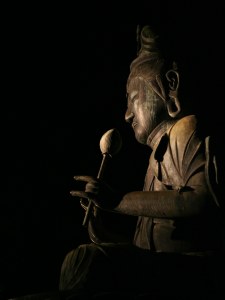
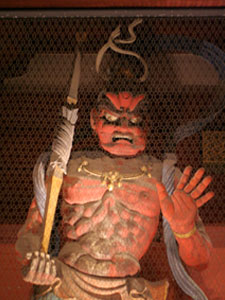
I met Andrew in a café in JR Ueno station, and we proceeded from there to wander around Tokyo for three days or so. We stayed in the Hotel New Koyo, which is almost certainly the cheapest hotel in Tokyo, at about 2700 Yen a night (about £13). It’s ok, too — it does the job. From that base, we spent several days wandering through Shinjuku, Shibuya, Asakusa and Ginza. Although we did manage a day-trip north to see Nikko’s waterfall and temples, for the most part the touristy stuff we tried to do (going to museums, kabuki, etc) ended up falling through for obscure reasons. One afternoon, in an attempt to see at least one museum, we decided to seek out the Tobacco and Salt Museum in Shibuya — partly because it was the nearest museum to the café we were sitting in, partly because it sounded so far off the beaten track that we thought the Tourism God might overlook it and let us through. No luck: we found it to be apparently non-existent, or at least not where our map claimed it was.
But to be honest, the tourist stuff is never the bit that I enjoy the most anyway. We did a good job of the more important business of wandering around the streets and tunnels and walkways of Tokyo, and sitting in cafés and eating foods. We also visited one of my favourite places in the city (a place I now find is called “Piss Alley”): a couple of alleys of old ramshackle buildings tucked in the armpit of a railway bridge behind Shinjuku station, a pocket of the Tokyo of about five decades ago among the skyscrapers of Shinjuku, full of noodle shops and little bars, steam and smoke and the smell of things barbecuing, and so narrow and with so much cabling overhead that it almost feels as if you’re underground until you look up through the cables to huge and distant neon.
The photos were taking walking around the grounds of Asakusa Temple after an almost-perfect meal of okonomiyaki — savoury pancakes which you fry yourself on a hotplate set into the table, and then cover with lots of mayonaise, dried fish flakes and salty preserved ginger — and cold beer in a little restaurant nearby.
]]>As a consequence of that event, Hiroshima is a city with a name that somehow seems too cold and weighty to be attached to a real place, let alone the buzzing, lively city that it is today. In fact, after Tokyo, Hiroshima is probably the most exciting city I’ve visited in Japan, and it’s certainly the prettiest – full of bridges and riverside parks, because it sits on a river delta (which also, for numerous reasons, is a large part of what made it an atomic bomb target 59 years ago). Standing on one of the bridges, you can look around, see the city reflected prettily in the river, and say to yourself ‘Hiroshima’, but the name just somehow doesn’t seem to attach to the thing it names in the way that names usually do. It sits in the mouth like a cold, flat stone. From time to time, walking round Hiroshima, you can’t help suddenly picturing the flash, and every time you immediately feel ghoulish for doing so, even though your brain is just trying to comprehend something incomprehensible.
Since about the time I read Slaughterhouse Five, I’ve been shocked by the ambivalent, “unfortunate-but-necessary” attitude that a lot of people in the UK still have towards certain of the Allies’ actions – Hiroshima, Dresden, Nagasaki – in the closing stages of the Second World War. Frightening what people are willing to accept if it’s done in the name of ‘fighting evil’. But though I can’t say that Hiroshima’s Peace Museum made me change my attitude towards the bombing – since I already firmly believed that there can never, under any circumstances whatsoever, be any moral justification for such an act – it did shake me by making it real. There’s something so incomprehensible about the event, that before I visited the Peace Museum – though I didn’t realise it – whenever I thought of ‘The Atomic Bombing of Hiroshima’, I was always thinking mostly in abstractions: history, causes, effects, number of dead, and so on. The museum, though, forces you to see it as a real event, in all its surreal horror.
But while certain of the museum’s exhibits are, necessarily, horrific, the installation that had the biggest impact on me was simply a scale model of the city, as it stood before the blast. Suspended over this model is a smooth, red ball, about 30cm across, and when you see this, you realise that the model is not – like other plans of cities – a timeless ‘Before’ but rather a snapshot of a single frozen grain of time – the 10,000th of a second after the bomb detonated. Looking at all the intact buildings, at the end of their final second, The Bomb suddenly loses all its abstract and historical associations, and becomes something with size, position, altitude, velocity, temperature, and so on. This – this crazy thing – is a decision that sane people made, and now here come the consequences.
Elsewhere the subsequent instant is also frozen: in a glass case, a watch, stopped at 8:15am by the blast.
As I said, I already believed that the bombing of Hiroshima was a criminal act, but the many historical details provided by the museum combined to leave the strong impression that many factors other than ‘ending the Second World War’ were behind the bombing: the bombing as ‘necessary’ to justify the astronomic cost of developing the bomb to the American public. The bombing as a horrendous scientific experiment: the Enola Gay – which dropped the bomb – was accompanied by a number of other planes whose function was to measure, photograph, and observe the explosion; Hiroshima was chosen in part because its geographical location, on a flat river delta surrounded by hills, would maximise the immediate effects of the blast, and no warning was given prior to the bombing. The bombing was also as much the start of the Cold War as the end of the World War: the Soviet Union had yet to declare war on Japan (it declared war on August 8th, two days after Hiroshima), and the US—terrified that post-war Japan could become communist—was desperate to end the war before Russia could become involved.
Another thing that impressed me about Hiroshima is the way it has turned its history into a positive force. It has been designated a ‘City of Peace’, and the local government is committed to ensuring that Hiroshima should forever be a warning and a reminder of the unacceptable cost of war: one wall of the museum is covered with letters written by the Mayor of Hiroshima to various ambassadors – of the US, UK, USSR, France, and so on – on the occasion of every nuclear test; each letter individually written, and protesting in the strongest terms that the majority of the world’s people do not wish the proliferation of nuclear weapons.
Outside the museum, in the Peace Park, a flame burns, which will be extinguished when the last nuclear weapon is scrapped. As with the red ball, as with the stopped clocks, it makes its impression by the awareness of time it quietly forces on you. You look at it, and you can’t help but wonder… decades? Centuries? When?
]]>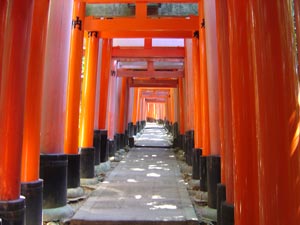
The morning after the Kobe conference finished, I went across to Kyoto – only about an hour by local train – to meet Ryoko sensei, who was my first Japanese teacher in Edinburgh. Although we’ve stayed in touch by email and postcard in the meantime, the last time I saw her was just before she left Edinburgh, about four years ago. We managed to meet up in Kyoto station by means of mobile phones (“Where are you? What can you see?”, “I’m… standing by a pillar, and I can see… what can I see? Taxis. Kyoto Tower Hotel… erm…”, and so on…). Very 久しぶり (hisashiburi), which means “long time no see” in Japanese. It was strange to think that last time we met, Japan was still just a sort-of imaginary place that I’d heard about and sometimes seen on tv, and now here we are, walking round actual Kyoto.
In fact, to make the most of being in Kyoto, we went for a wander around the grounds of Fushimi-inari Shrine (伏見稲荷大社). “Inari” (稲荷) means that it’s a fox shrine – dedicated to Inari, the deity of foxes, harvest, and prosperity. Unlike a lot of Kyoto’s other temples and shrines, Fushimi-inari isn’t particularly impressive on first sight. The interesting thing is not the shrine itself, so much as the torii (shinto gate) lined paths that wind through its grounds (as in the photo). Since Inari is a god of prosperity, lots of businesses pay to have one of these large, bright red gates built on the grounds of the shrine as an offering, and consequently the paths through the woods around it are lined with thousands upon thousands of gates, of various ages. Fushimi-inari’s amazingness creeps up on you gradually as you walk through the woods, and you begin to realise that the rows of torii just keep going and going. The day that I went there with Ryoko sensei, the weather was perfect: cloudless blue sky, bright sunshine, and just this side of too hot. The woods around the shrine were cool, with patches of bright sunlight scattered about, and the bright orange-red gates stood out beautifully against the bright green of the trees. I suppose Fushimi-inari (like other places in Kyoto) would be quite a different experience with each season – the constant orange of the gates set against a changing background of green summer leaves, red autumn leaves, snow, and then blossom. Have to go back to find out. The other thing I liked about Fushimi-inari is the feeling that it’s still alive: so many tourist attractions feel almost hermetically-sealed for posterity, but torii continue to be built, and further into the woods, they become more widely spaced out. So Fushimi-inari will presumably just keep growing out into the woods for a long time to come.
]]>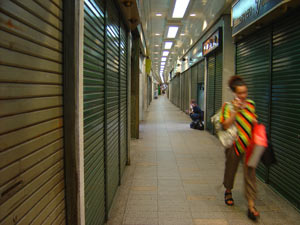
The first and longest stop on my one-week tour of mainland Japan was Kobe, which is a largish city right in the center of Japan’s largest island, Honshu, close to both Osaka and Kyoto, and probably most famous outside Japan for the earthquake that devastated it in 1995. Nowadays, it’s a bustling, modern Japanese city, but with few tourist attractions or even distinguishing features apart from the large, man-made Port Island, on which my hotel was located, and the pretty hills that are its backdrop.
… Argh. I could have just torn that out of a tourist guide, couldn’t I? Let’s start again, because I wasn’t there as a tourist – I was there for a three-day recontracting conference, along with a thousand or so other JET teachers who, like me, are staying on for a second year. Three days of workshops, in which unqualified teachers try to teach other unqualified teachers to teach (actually, that’s unnecessarily cynical – some of them were actually quite useful, and there are a lot of JET teachers who, although they might not be any more qualified than me, are clearly better teachers who I can learn from), and three nights drinking in central Kobe, because it’s pretty rare nowadays that I get the chance to sit in a pub and chat in fluent, rambling English. And even rarer that I get the chance to drink a pint of decent Guiness or Hoegaarden (the price of a pint of which is so obscenely astronomical here that I don’t even want to think about how much bad karma I got from buying it anyway…)
A couple of memory fragments:
-
Getting into a taxi with a couple of other JETs, which contained a huge liquid crystal tv screen in the front. As we drove off, the taxi driver inserted a DVD, and turned the resulting orchestral music up to a crazy volume. While the sound quality was excellent, it did make it almost impossible to talk, so I asked him (the only way I could think of in Japanese) if he could make it a little quieter. He did, but was a little put out and told me that what I should have said was something like ‘although I don’t hate this music, it is a little loud…’
-
Learning a useful lesson about the dangers of theorising about Japan (which seems to be a popular pastime with foreigners here). I was sitting in a very nice, dark little bar with Graeme, another JET, and we were talking about something we’d both noticed in Kobe: people cross the road on a red light. This is very unusual in Japan – in Tokyo, Osaka, Kyoto, and everywhere else I’ve been, people generally wait patiently for the green man. I’ve got so used to stopping at the crossing like everyone else that I was shocked to see people everywhere walking straight out while the man’s still red. I wondered what’s special about Kobe, and Graeme wondered if it could be to do with the earthquake – a ‘life’s-too-short’ sort of attitude particular to Kobe. Wow, I thought. That could be right: 5000 people died in the Kobe earthquake, which means that probably most of the city’s residents lost someone they knew. So we asked the barmaid, tactfully: Is there something special about Kobe? Why does everyone cross on the red light here? Oh, I cross the road out there on the red the whole time, she says: the roads in central Kobe are almost all one-way, see, so they’re easy to cross. There we were, looking for historical, socio-psychological explanations for something that is actually explained by a difference in the city’s traffic system…
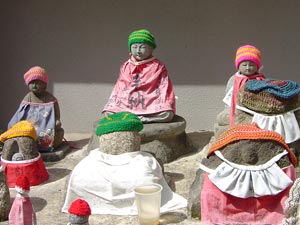
I’m back on the island after a week or so’s absence going round Kyoto and Okinawa with my parents. On my previous, brief visit to Kyoto at New Year, I only saw a couple of temples, but this time the cherry-trees exploded into blossom on about the day after we arrived, and we went temple-beserk. If you find yourself in Kyoto, my top two temples are Kinkakuji (金閣寺), the Golden Pavilion, which – true to its name – is almost entirely covered in gold, and Kiyomizu Temple (清水寺), which is a collection of several buildings, all very different, and each of which individually would kick the arse of most other temples in the vicinity.
Quite a few of the temples had Zen rock gardens, and I was surprised to find that while some immediately struck me as balanced and peaceful and quite possibly the product of someone who knows something rather profound, others, though superficially similar, seemed as if someone had just raked some gravel into pretty shapes. I began to wonder if my instant discrimination between ‘fake’ and ‘real’ Zen gardens was a sign that I understood something – perhaps even of imminent enlightenment – but my optimism was shattered when, on reaching the last garden of the day (one of the ‘real’ ones) whose only prominent features were two large and slightly rounded mounds that seemed to be emerging from an otherwise calm sea of gravel, one of the first thoughts to ripple the tranquil, pondlike surface of my mind concerned their hilarious (and not entirely vague) resemblance to… the breasts on a lady! Imagine that! A great big nude lady, hiding under the gravel, just biding her time, waiting to jump out and startle a passing monk!
]]>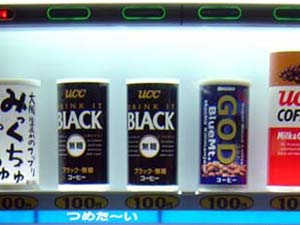
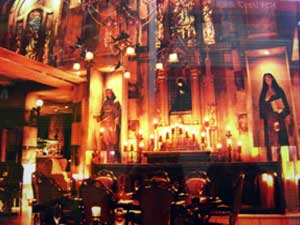
I found God in a coffee can in a vending machine in southern Osaka. So that’s where He’s been all this time.
What a peculiar fellow!
We also walked past a Christ-themed restaurant. Or rather a restaurant whose aesthetic seems to be a Japanese take on Catholicism at its most gothic and florid. A slogan in the window informs passers-by that:
“The shiny golden altar in our shop is real, and it was used at the church in Europe. Please enjoy our perfect situation, service, dishes and music. We are imagining like a church. It is a perfect space for adult. Please enjoy your time.”
After I’d picked my jaw off the ground and put it back in place, I was surprised to realise that I was actually offended. Not that I’m a Christian, and I’m still less of a Catholic, but I think it was the amount of disrespect involved in treating a religion as just another source of inspiration for interior design (although now I think about it, I wonder if that isn’t exactly how a lot of Westerners see, say, Zen Buddhism…) The sheer wrongness of it reminded me of the time a friend (Dave) went to Florida and saw an adventure playground based on the sinking of the Titanic. Although obviously, that’s much, much wronger.
]]>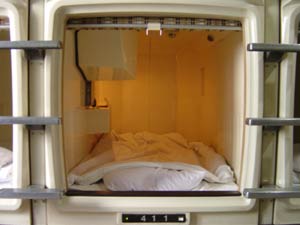
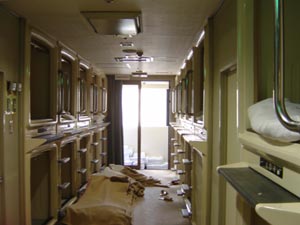
The first night of this year, I slept in a capsule hotel. And – contrary to my expectations – they’re not bad! A Japanese friend once told me that you shouldn’t go to capsule hotels because ‘only strange businessmen stay in them’, and it did sound like a recipe for a night of unsettling half-formed dreams about being trapped in a box by a man with a thin moustache and strange, black eyes like weird oily marbles. But in fact, it’s really a bit like a youth hostel, albeit a youth hostel where you sleep in a small compartment. The capsules are stacked along the walls of a dormitory, which means that while you are in a communal space of sorts, you’re also separate enough to be able to ignore people walking about or coughing. Each capsule has a roller blind that comes down over the entrance, which means that while you’re in your own space, it still has the air-flow and acoustics of a larger place, so it doesn’t feel claustrophobic (as it would if there was a door you closed behind you).
The capsules are quite well-appointed, as three-foot high box-shaped living-spaces go, with a radio, a TV, and a little shelf on top of the radio to put things on (you put your bags / coat in a locker outside the dorm room).
The other thing that surprised me was the 1970s feel of the whole place. I now realise that capsule hotels were a 1970s idea, but for some reason I was expecting something more 21st century. Instead, the place really had the feel of the dormitory of a spacecraft constructed in the early seventies. Especially at night, when the main light was very low, and lights glowed by the entrance of each capsule. I also seem to remember a low background hum, like the throb of distant engines, but maybe my memory has added that detail retrospectively…
Capsule hotels are also very, very cheap: one night (including breakfast) cost a little over 2000 yen – which is about 12 pounds sterling – even though the hotel was right in the middle of Osaka.
Another TV advert: a naked woman stands caressing a long, nicely-planed plank of wood. I am beginning to wonder whether I actually see the same things everyone else sees when I watch TV …
]]>